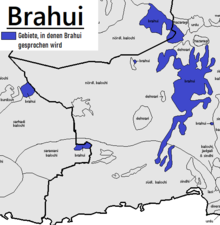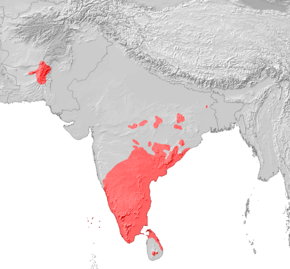Brahui language
Brahui (brāhōī) is a language from the Dravidian language family spoken in Pakistan, Afghanistan, and Iran. It is included in the Northern Dravidian branch of this language family, along with Kurukh and Malto.
The Brahui speakers are members of the semi-nomadic tribe of the same name in Balochistan. Most of them live in Pakistan in the area of Quetta, Mastung, Kalat and Las Bela. Smaller groups of Brahui speakers are also found in the Shorawak Desert in Afghanistan and in Sistan, Iran. Since the late 19th century, a small number of Brahui speakers have also lived in the Merw Oasis in Turkmenistan. Many Brahui also live as migrant workers in the major cities of Pakistan. Many members of the Brahui tribe also speak Baloch as their mother tongue or are bilingual. Therefore, exact speaker numbers are also difficult to determine: Ethnologue puts the number of Brahui speakers at 2.2 million, while Ivory 1998 estimates 100,000 first language speakers and 300,000 second language speakers.
Historical reports about the Brahuis only exist from the 17th century onwards, when they joined together with the Baluch and members of the Dehwar tribe to form the Khanate of Kalat. This semi-independent state lasted until 1948. The name Brahui is derived from the name Ibrahim via the Siraiki form brāhō. The antecedents of the language are entirely unexplained. The location of the Brahui language area in the northwest of the Indian subcontinent, far from the other languages of the family spoken largely in southern India, has given rise to much speculation. For instance, some researchers assume that the Brahuis reached the area as early as during the Dravidian immigration to India 5000 years ago. The presence of Brahui has also been invoked for the theory that the language of the Indus culture was Dravidian. Other researchers, however, assume that the Brahuis migrated from the central Indian Deccan only between 800 and 1100 AD.
Most Brahui speakers are illiterate, yet the language has a certain literary tradition. The oldest known Brahui-language work is the Tuḥfat al-ʿajāʾib of 1,275 verses by the poet Malikdad Gharshin Qalati (1760). In the late 19th century, Islamic Deobandis endeavored to make Brahui a written language. For this purpose, they created an orthography in the Persian Arabic script modeled on Urdu. In the 20th century, the Brahui Association (Brāhūī Jamāʿat) was founded to promote Brahui literature. Since 1966, the Brahui Academy in Quetta has taken on this task.
Brahui is divided into a northern dialect, Sarawan, and a southern dialect, Jahlawan. However, these are not too different from each other. Brahui has been strongly influenced by the surrounding Indo-European languages, especially Baluchi. This is particularly evident in the vocabulary, where only 10 percent of the words are of Dravidian origin. Twenty percent of the vocabulary is from Baluchi, 30 percent from Persian and Arabic, and for 40 percent the origin is unclear. Even of the numeral words, only the first three are Dravidian (1 asi(ṭ ), 2 irā(ṭ ), 3 musi(ṭ )), the rest being borrowed from Baluch (4 čār, 5 panč, 6 šaš, 7 haft, 8 hašt, 9 nō(h), 10 dah).
A well known Brahui singer in Pakistan is Babul Jan.

Areas where Brahui is spoken

Distribution area of the Dravidian languages; in the extreme northwest (top left) the distribution area of Brahui
Search within the encyclopedia